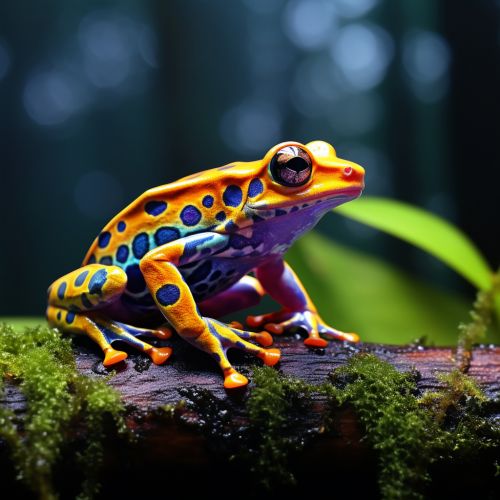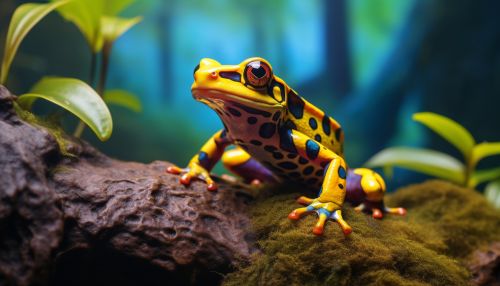Amphibian
Classification and Characteristics
Amphibians are a group of cold-blooded vertebrates constituting the class Amphibia. They are one of the three types of animals that fall under the category of tetrapods, the others being reptiles and mammals. They are characterized by their ability to live both in water and on land, a trait that has earned them their name, which comes from the Greek words 'amphi', meaning 'both', and 'bios', meaning 'life'.


Amphibians are further divided into three orders: Anura (frogs and toads), Caudata (salamanders and newts), and Gymnophiona (caecilians). Each of these orders has unique characteristics that distinguish them from one another. For instance, members of the Anura order are typically characterized by their long hind legs and lack of tail, while those of the Caudata order have long bodies and tails, and short limbs. Gymnophiona, on the other hand, are limbless and resemble large worms or snakes.
Evolution and Fossil Record
The first amphibians evolved from lobe-finned fish around 370 million years ago during the Devonian period. This transition from aquatic to terrestrial life marked a significant milestone in the history of life on Earth, as it paved the way for the evolution of all subsequent land-dwelling vertebrates. The earliest known amphibian is the extinct genus Ichthyostega, which had both fish-like and tetrapod-like features.
The fossil record of amphibians is relatively sparse due to their soft bodies and aquatic lifestyle, which do not lend themselves well to fossilization. However, the fossils that have been discovered provide valuable insights into the evolution and diversity of this group of animals.
Anatomy and Physiology
Amphibians have a number of anatomical and physiological adaptations that allow them to survive in both aquatic and terrestrial environments. These include a semi-permeable skin that allows for respiration, a three-chambered heart that circulates blood efficiently, and a double-loop circulatory system that separates oxygenated and deoxygenated blood.
One of the most distinctive features of amphibians is their skin, which is typically smooth and moist. The skin serves multiple functions, including respiration, osmoregulation, and protection against predators. Some amphibians, such as certain species of frogs and toads, also have specialized glands in their skin that produce toxic secretions as a defense mechanism.
Reproduction and Life Cycle
Amphibians have a complex life cycle that typically involves a larval stage followed by metamorphosis into an adult. The most well-known example of this is the transformation of a tadpole into a frog. During the larval stage, the amphibian lives in water and has gills for breathing. As it matures, it undergoes a process of metamorphosis, during which it develops lungs and legs, and loses its tail.
Reproduction in amphibians usually involves external fertilization, with the female laying eggs in water and the male fertilizing them externally. However, there are exceptions to this, with some species exhibiting internal fertilization and others giving live birth.
Ecology and Behavior
Amphibians play a crucial role in their ecosystems, serving as both predators and prey. They help to control insect populations and provide a food source for a variety of other animals, including birds, mammals, and reptiles.
Many amphibians are nocturnal and have a variety of adaptations that help them survive in their environments. These include excellent night vision, the ability to change color to blend in with their surroundings, and a variety of defensive behaviors such as playing dead or producing toxic secretions.
Conservation Status
Amphibians are one of the most threatened groups of animals on the planet, with over a third of species considered to be at risk of extinction. The main threats to amphibians include habitat loss, pollution, climate change, and diseases such as chytridiomycosis, a deadly fungal disease that has caused significant declines in amphibian populations worldwide.
Conservation efforts for amphibians include habitat protection, captive breeding programs, and research into the causes and potential solutions to the threats they face.
